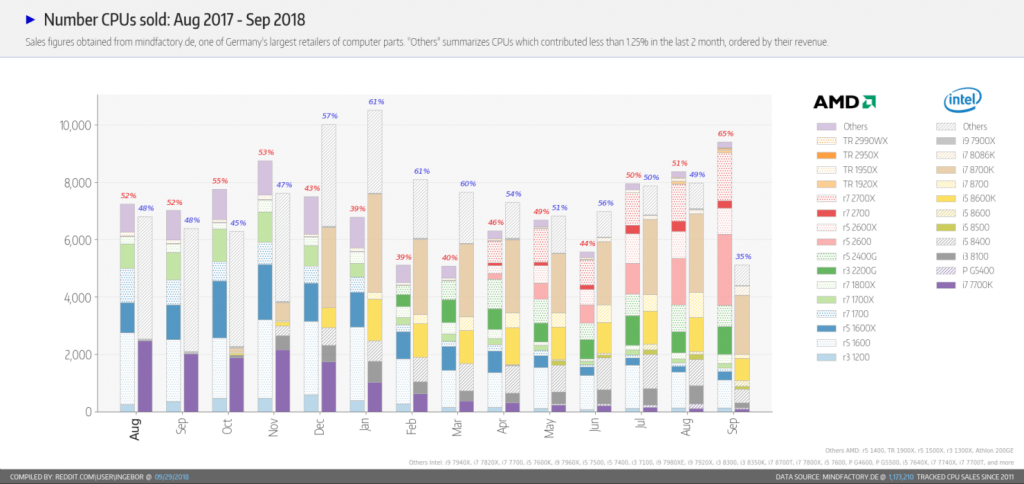
There are two brands synonymous with desktop processors, Intel and AMD. Both offer a number of great chipsets, some offer good value, some not so much. Intel has always been criticized as overpriced, but better performers. On the other end, AMD has been quoted “bang for your buck” multiple times and is a favorite among content creators. With that said, there is no surprise which one shipped more products in the last couple of years.
Thanks to numerous price cuts on multiple chipsets and Intel’s supply problems, AMD just managed to double market share. First, let’s clear a few things up, Intel CPUs aren’t exactly inferior to that of AMD. Because Intel cannot push out enough of its 14nm based chipsets, which affects both of it’s “Xeon” and “Core” lineup, there has been a few consequences. First of which is a hike in prices.

The already expensive chipsets are now receiving price hikes, and that’s not a good thing. What makes it even worse? AMD has been slicing off the prices from it’s already “value for money” products, and you probably get what I am saying. Increase in demand and decrease in supply will eventually result in price hikes. But when that happens, the demand actually decreases, and everyone moves to the next best thing.
Addressing this issue, Intel has started taking steps in order to fix this current situation. Here is the press release from Intel:
The surprising return to PC TAM growth has put pressure on our factory network. We’re prioritizing the production of Intel Xeon and Intel Core processors so that collectively we can serve the high-performance segments of the market.
That said, supply is undoubtedly tight, particularly at the entry-level of the PC market. We continue to believe we will have at least the supply to meet the full-year revenue outlook we announced in July, which was $4.5 billion higher than our January expectations.
To address this challenge, we’re taking the following actions:
- We are investing a record $15 billion in capital expenditures in 2018, up approximately $1 billion from the beginning of the year. We’re putting that $1 billion into our 14nm manufacturing sites in Oregon, Arizona, Ireland, and Israel. This capital along with other efficiencies is increasing our supply to respond to your increased demand.
- We’re making progress with 10nm. Yields are improving and we continue to expect volume production in 2019.
- We are taking a customer-first approach. We’re working with your teams to align demand with available supply. You can expect us to stay close, listen, partner and keep you informed.
















![Best Ultrabooks To Buy in Nepal 2024 [Updated] Best Ultrabook Laptops in Nepal 2023 - June Update](https://cdn.gadgetbytenepal.com/wp-content/uploads/2023/04/Best-Ultrabook-Laptops-in-Nepal-2023-June-Update.jpg)
![Best Gaming Laptops in Nepal 2024 [Updated] Best Gaming Laptops in Nepal 2023 - June Update](https://cdn.gadgetbytenepal.com/wp-content/uploads/2023/04/Best-Gaming-Laptops-in-Nepal-2023-June-Update.jpg)


![Best Mobile Phones Under Rs. 15,000 in Nepal [Updated] Best Phones Under 15000 in Nepal 2024 Budget Smartphones Cheap Affordable](https://cdn.gadgetbytenepal.com/wp-content/uploads/2024/03/Best-Phones-Under-15000-in-Nepal-2024.jpg)
![Best Mobile Phones Under Rs. 20,000 in Nepal [Updated] Best Mobile Phones Under NPR 20000 in Nepal 2023 Updated Samsung Xiaomi Redmi POCO Realme Narzo Benco](https://cdn.gadgetbytenepal.com/wp-content/uploads/2024/01/Best-Phones-Under-20000-in-Nepal-2024.jpg)
![Best Mobile Phones Under Rs. 30,000 in Nepal [Updated]](https://cdn.gadgetbytenepal.com/wp-content/uploads/2023/12/Best-Phones-Under-30000-in-Nepal-2024.jpg)
![Best Mobile Phones Under Rs. 40,000 in Nepal [Updated] Best Phones Under 40000 in Nepal 2024 Smartphones Mobile Midrange](https://cdn.gadgetbytenepal.com/wp-content/uploads/2024/02/Best-Phones-Under-40000-in-Nepal-2024.jpg)
![Best Mobile Phones Under Rs. 50,000 in Nepal [Updated] Best Phones Under 50000 in Nepal 2024 Smartphones Midrange](https://cdn.gadgetbytenepal.com/wp-content/uploads/2024/02/Best-Phones-Under-50000-in-Nepal-2024.jpg)
![Best Flagship Smartphones To Buy In Nepal [Updated] Best Smartphones in Nepal 2024 Flagship Premium Samsung Apple iPhone Xiaomi OnePlus Honor](https://cdn.gadgetbytenepal.com/wp-content/uploads/2023/09/Best-Smartphones-in-Nepal-2024.jpg)